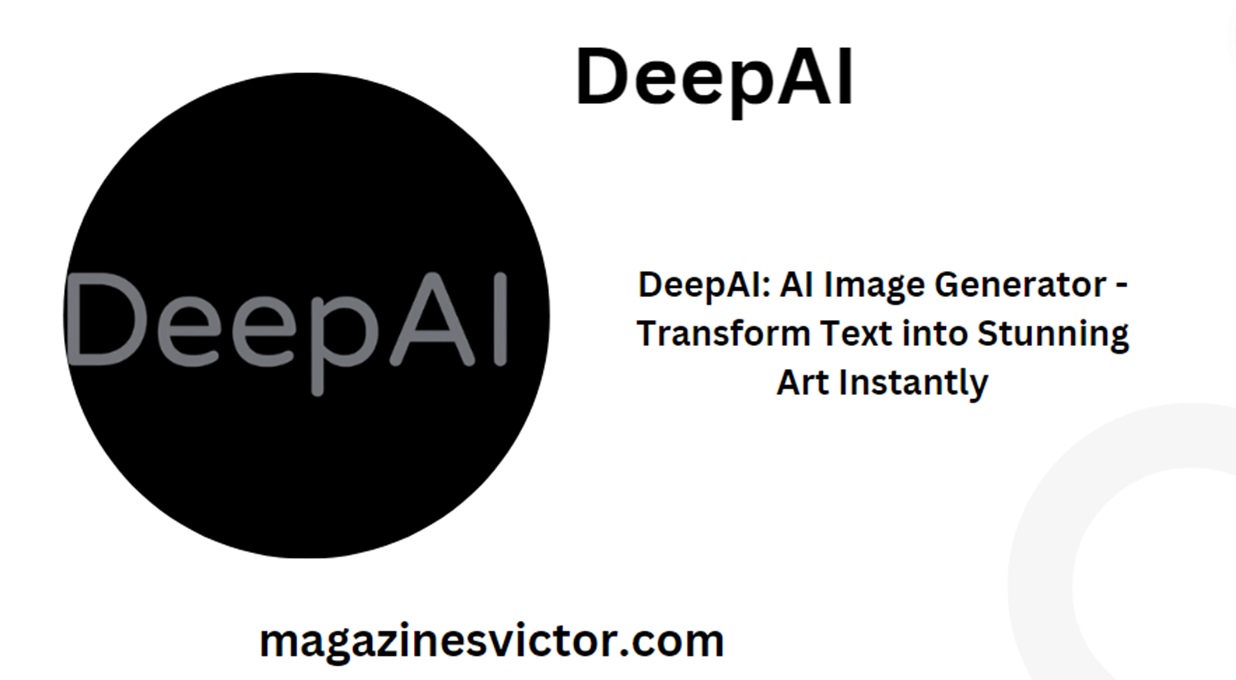
deepai
Introduction
In the ever-evolving landscape of artificial intelligence (AI), one of the most fascinating and rapidly developing areas is the generation of images from text descriptions. This technology, which lies at the intersection of computer vision and natural language processing, has given rise to tools that can create visual content based on textual prompts. Among these tools, DeepAI stands out as a pioneering platform that offers robust and versatile AI-powered solutions for image generation. This article explores the capabilities, applications, and impact of DeepAI’s image generator, delving into how it transforms text into art and the broader implications of this technology.
Table of Contents
The Genesis of DeepAI
DeepAI was founded with the vision of making advanced AI technologies accessible to a broad audience. Since its inception, DeepAI has focused on providing tools that leverage the power of AI to simplify and enhance creative processes. The platform initially gained attention for its text-to-image generator, which was among the first of its kind to be available online. Over time, DeepAI expanded its offerings to include a wide range of AI-driven tools, including chatbots, video generators, and image editors (Unite.AI).
How DeepAI’s Image Generator Works
At its core, DeepAI’s image generator utilizes a combination of deep learning models and sophisticated algorithms to interpret and visualize text descriptions. The process involves several key steps:
- Text Analysis: The input text is first analyzed to understand the context, objects, and actions described. This involves natural language processing (NLP) techniques that break down the text into manageable components.
- Semantic Mapping: The parsed text is then mapped to semantic concepts that the AI model understands. This step involves linking words and phrases to visual elements, such as shapes, colors, and objects.
- Image Synthesis: Using a generative adversarial network (GAN) or a similar deep learning architecture, the system synthesizes an image that represents the textual description. The model iterates through multiple stages of refinement to improve the quality and accuracy of the generated image.
- Style Application: Users can choose from various art styles to apply to the generated image, allowing for customization and artistic expression. This step leverages style transfer techniques to blend the generated content with the desired artistic effect (DeepAI) (DeepAI).
Key Features of DeepAI’s Image Generator
Versatility in Art Styles
One of the standout features of DeepAI’s image generator is its ability to produce images in a wide array of styles. Whether users are looking for baroque art, gothic imagery, surreal dreamscapes, or modern abstract expressionism, the platform offers numerous options to cater to diverse artistic preferences. This versatility enables users to experiment with different visual aesthetics and find the perfect match for their creative projects (DeepAI).
User-Friendly Interface
DeepAI is designed to be accessible to users of all skill levels. The platform features an intuitive interface that simplifies the process of generating images from text. Users can enter a description, select an art style, and generate an image with just a few clicks. This ease of use makes it an attractive tool for artists, designers, marketers, and hobbyists alike (DeepAI).
Integration and API Access
For developers and businesses, DeepAI offers robust API access, allowing seamless integration of its image generation capabilities into other applications and workflows. This feature is particularly valuable for companies looking to incorporate AI-driven image creation into their products, whether for marketing, entertainment, or other creative endeavors (DeepAI).
Commercial Licensing
DeepAI provides commercial licensing options, making it feasible for businesses to use its technology for commercial purposes. This flexibility ensures that companies can legally and effectively utilize AI-generated images in their products, marketing campaigns, and other business activities (Futurepedia).
Applications of DeepAI’s Image Generator
Art and Design
For artists and designers, DeepAI’s image generator is a powerful tool that expands creative possibilities. It allows users to quickly visualize concepts, experiment with different styles, and generate unique artworks that can serve as inspiration or final pieces. This tool can be particularly useful for concept artists, illustrators, and graphic designers looking to streamline their creative process and explore new artistic territories (DeepAI).
Marketing and Advertising
In the marketing and advertising industries, visual content plays a crucial role in capturing audience attention and conveying messages effectively. DeepAI’s image generator enables marketers to create bespoke images tailored to specific campaigns, enhancing the visual appeal and impact of their promotional materials. This capability is especially valuable for social media marketing, where engaging visuals are key to driving user engagement and brand awareness (Futurepedia).
Entertainment and Media
The entertainment industry can also benefit from DeepAI’s image generation technology. From creating concept art for movies and video games to generating unique visuals for music videos and online content, the possibilities are vast. The ability to quickly produce high-quality images based on text descriptions can significantly accelerate the content creation process, allowing creators to focus more on storytelling and less on manual illustration (DeepAI).
Education and Research
In educational settings, DeepAI’s image generator can be used as a teaching tool to illustrate concepts and ideas. For instance, educators can generate images to accompany lesson plans, making complex topics more accessible and engaging for students. Researchers in fields such as computer vision and NLP can also leverage the platform to experiment with new models and techniques, advancing the state of AI technology (Unite.AI).
The Broader Implications of AI Image Generation
Ethical Considerations
As with any advanced technology, the use of AI image generators raises several ethical considerations. One concern is the potential for misuse, such as generating misleading or harmful content. DeepAI addresses this issue by implementing safeguards to prevent inappropriate use and by promoting ethical guidelines for AI-generated content. Additionally, the platform encourages users to be mindful of the ethical implications of their creations and to use the technology responsibly (DeepAI).
Impact on Traditional Art
The rise of AI-generated art has sparked a debate about its impact on traditional art forms. Some argue that AI tools democratize art creation, making it accessible to a broader audience. Others worry that it may devalue the skills and efforts of human artists. While AI can replicate and generate images, it lacks the human touch and emotional depth that traditional art embodies. Ultimately, AI-generated art should be seen as a complement to, rather than a replacement for, human creativity (Unite.AI).
Future Prospects
The future of AI image generation is promising, with potential advancements in both technology and applications. As AI models become more sophisticated, we can expect even more accurate and high-quality image generation. Furthermore, the integration of AI with other emerging technologies, such as augmented reality (AR) and virtual reality (VR), could open up new possibilities for immersive and interactive art experiences. DeepAI is likely to continue playing a pivotal role in this evolving landscape, driving innovation and expanding the boundaries of what AI can achieve (Unite.AI) (Futurepedia).
Conclusion
Deep AI’s AI image generator represents a significant milestone in the field of artificial intelligence and creative technology. By transforming text descriptions into vivid and diverse images, the platform empowers users to explore new creative horizons and enhances the efficiency of visual content creation. Whether for art, design, marketing, entertainment, or education, Deep AI offers versatile and powerful tools that cater to a wide range of applications. As AI technology continues to advance, Deep AI is poised to remain at the forefront of this exciting and transformative field, shaping the future of art and creativity.
In summary, Deep AI’s image generator is not just a tool for creating art from text; it is a gateway to a new realm of creative possibilities. By harnessing the power of AI, Deep AI enables users to turn their imaginative ideas into reality, fostering innovation and inspiring creativity across various domains. As we continue to explore the potential of AI, platforms like Deep AI will undoubtedly play a crucial role in shaping the future of creative expression.



